
Illustrative Math Alignment: Grade 6 Unit 1
Dividing Fractions
Lesson 16: Solving Problems Involving Fractions
Use the following Media4Math resources with this Illustrative Math lesson.
| Thumbnail Image | Title | Body | Curriculum Nodes |
|---|---|---|---|
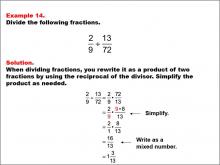
|
Math Example: Fraction Operations--Dividing Fractions: Example 14 | Dividing Fractions: Example 14TopicFraction Operations DescriptionThis example focuses on the division of fractions by utilizing the reciprocal of the divisor. The process is visually depicted, allowing learners to follow the transformation from division to multiplication. The result is a mixed number. Essential skills include understanding the concept of reciprocals, executing multiplication of fractions, and simplifying the final result. This example aids in reinforcing the understanding of how dividing fractions is essentially multiplying by the inverse, a critical concept in fraction arithmetic. |
Fractions and Mixed Numbers |

|
Math Example: Fraction Operations--Dividing Fractions: Example 14 | Dividing Fractions: Example 14TopicFraction Operations DescriptionThis example focuses on the division of fractions by utilizing the reciprocal of the divisor. The process is visually depicted, allowing learners to follow the transformation from division to multiplication. The result is a mixed number. Essential skills include understanding the concept of reciprocals, executing multiplication of fractions, and simplifying the final result. This example aids in reinforcing the understanding of how dividing fractions is essentially multiplying by the inverse, a critical concept in fraction arithmetic. |
Fractions and Mixed Numbers |

|
Math Example: Fraction Operations--Dividing Fractions: Example 14 | Dividing Fractions: Example 14TopicFraction Operations DescriptionThis example focuses on the division of fractions by utilizing the reciprocal of the divisor. The process is visually depicted, allowing learners to follow the transformation from division to multiplication. The result is a mixed number. Essential skills include understanding the concept of reciprocals, executing multiplication of fractions, and simplifying the final result. This example aids in reinforcing the understanding of how dividing fractions is essentially multiplying by the inverse, a critical concept in fraction arithmetic. |
Fractions and Mixed Numbers |
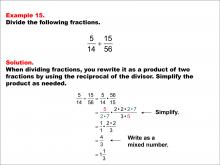
|
Math Example: Fraction Operations--Dividing Fractions: Example 15 | Dividing Fractions: Example 15TopicFraction Operations DescriptionThis example illustrates the division of fractions by converting the operation into multiplication using the reciprocal of the divisor. The image provides a clear step-by-step guide, emphasizing the importance of reciprocal multiplication. The result is a mixed number. Skills involved include recognizing and applying reciprocal relationships, performing multiplication, and simplifying fractions. This example is crucial for understanding the fundamental principle that dividing by a fraction is equivalent to multiplying by its reciprocal, a key concept in fraction operations. |
Fractions and Mixed Numbers |

|
Math Example: Fraction Operations--Dividing Fractions: Example 15 | Dividing Fractions: Example 15TopicFraction Operations DescriptionThis example illustrates the division of fractions by converting the operation into multiplication using the reciprocal of the divisor. The image provides a clear step-by-step guide, emphasizing the importance of reciprocal multiplication. The result is a mixed number. Skills involved include recognizing and applying reciprocal relationships, performing multiplication, and simplifying fractions. This example is crucial for understanding the fundamental principle that dividing by a fraction is equivalent to multiplying by its reciprocal, a key concept in fraction operations. |
Fractions and Mixed Numbers |

|
Math Example: Fraction Operations--Dividing Fractions: Example 15 | Dividing Fractions: Example 15TopicFraction Operations DescriptionThis example illustrates the division of fractions by converting the operation into multiplication using the reciprocal of the divisor. The image provides a clear step-by-step guide, emphasizing the importance of reciprocal multiplication. The result is a mixed number. Skills involved include recognizing and applying reciprocal relationships, performing multiplication, and simplifying fractions. This example is crucial for understanding the fundamental principle that dividing by a fraction is equivalent to multiplying by its reciprocal, a key concept in fraction operations. |
Fractions and Mixed Numbers |

|
Math Example: Fraction Operations--Dividing Fractions: Example 15 | Dividing Fractions: Example 15TopicFraction Operations DescriptionThis example illustrates the division of fractions by converting the operation into multiplication using the reciprocal of the divisor. The image provides a clear step-by-step guide, emphasizing the importance of reciprocal multiplication. The result is a mixed number. Skills involved include recognizing and applying reciprocal relationships, performing multiplication, and simplifying fractions. This example is crucial for understanding the fundamental principle that dividing by a fraction is equivalent to multiplying by its reciprocal, a key concept in fraction operations. |
Fractions and Mixed Numbers |

|
Math Example: Fraction Operations--Dividing Fractions: Example 15 | Dividing Fractions: Example 15TopicFraction Operations DescriptionThis example illustrates the division of fractions by converting the operation into multiplication using the reciprocal of the divisor. The image provides a clear step-by-step guide, emphasizing the importance of reciprocal multiplication. The result is a mixed number. Skills involved include recognizing and applying reciprocal relationships, performing multiplication, and simplifying fractions. This example is crucial for understanding the fundamental principle that dividing by a fraction is equivalent to multiplying by its reciprocal, a key concept in fraction operations. |
Fractions and Mixed Numbers |

|
Math Example: Fraction Operations--Dividing Fractions: Example 15 | Dividing Fractions: Example 15TopicFraction Operations DescriptionThis example illustrates the division of fractions by converting the operation into multiplication using the reciprocal of the divisor. The image provides a clear step-by-step guide, emphasizing the importance of reciprocal multiplication. The result is a mixed number. Skills involved include recognizing and applying reciprocal relationships, performing multiplication, and simplifying fractions. This example is crucial for understanding the fundamental principle that dividing by a fraction is equivalent to multiplying by its reciprocal, a key concept in fraction operations. |
Fractions and Mixed Numbers |
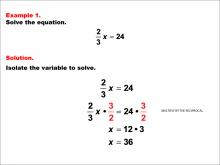
|
Math Example--Solving Equations--Equations with Fractions: Example 1 | Equations with Fractions: Example 1TopicEquations |
Solving Fraction Equations |

|
Math Example--Solving Equations--Equations with Fractions: Example 1 | Equations with Fractions: Example 1TopicEquations |
Solving Fraction Equations |

|
Math Example--Solving Equations--Equations with Fractions: Example 1 | Equations with Fractions: Example 1TopicEquations |
Solving Fraction Equations |

|
Math Example--Solving Equations--Equations with Fractions: Example 1 | Equations with Fractions: Example 1TopicEquations |
Solving Fraction Equations |
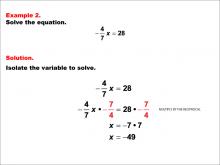
|
Math Example--Solving Equations--Equations with Fractions: Example 2 | h1>Equations with Fractions: Example 2 TopicEquations |
Solving Fraction Equations |

|
Math Example--Solving Equations--Equations with Fractions: Example 2 | h1>Equations with Fractions: Example 2 TopicEquations |
Solving Fraction Equations |

|
Math Example--Solving Equations--Equations with Fractions: Example 2 | h1>Equations with Fractions: Example 2 TopicEquations |
Solving Fraction Equations |

|
Math Example--Solving Equations--Equations with Fractions: Example 2 | h1>Equations with Fractions: Example 2 TopicEquations |
Solving Fraction Equations |

|
Math Example--Solving Equations--Equations with Fractions: Example 2 | h1>Equations with Fractions: Example 2 TopicEquations |
Solving Fraction Equations |
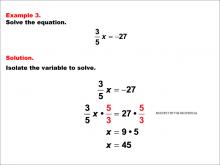
|
Math Example--Solving Equations--Equations with Fractions: Example 3 | Equations with Fractions: Example 3TopicEquations |
Solving Fraction Equations |

|
Math Example--Solving Equations--Equations with Fractions: Example 3 | Equations with Fractions: Example 3TopicEquations |
Solving Fraction Equations |

|
Math Example--Solving Equations--Equations with Fractions: Example 3 | Equations with Fractions: Example 3TopicEquations |
Solving Fraction Equations |

|
Math Example--Solving Equations--Equations with Fractions: Example 3 | Equations with Fractions: Example 3TopicEquations |
Solving Fraction Equations |

|
Math Example--Solving Equations--Equations with Fractions: Example 3 | Equations with Fractions: Example 3TopicEquations |
Solving Fraction Equations |
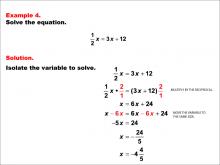
|
Math Example--Solving Equations--Equations with Fractions: Example 4 | Equations with Fractions: Example 4TopicEquations DescriptionThis example illustrates solving Equations with Fractions: Example 4 which involves fractions. These equations can be addressed by first removing the fractions by finding a common denominator and multiplying through. This transforms the equation into a standard linear form that can then be solved by isolating the variable. The specific equation in the image shows the importance of maintaining accuracy in operations, and understanding the process is crucial for advancing in algebra. |
Solving Fraction Equations |

|
Math Example--Solving Equations--Equations with Fractions: Example 4 | Equations with Fractions: Example 4TopicEquations DescriptionThis example illustrates solving Equations with Fractions: Example 4 which involves fractions. These equations can be addressed by first removing the fractions by finding a common denominator and multiplying through. This transforms the equation into a standard linear form that can then be solved by isolating the variable. The specific equation in the image shows the importance of maintaining accuracy in operations, and understanding the process is crucial for advancing in algebra. |
Solving Fraction Equations |

|
Math Example--Solving Equations--Equations with Fractions: Example 4 | Equations with Fractions: Example 4TopicEquations DescriptionThis example illustrates solving Equations with Fractions: Example 4 which involves fractions. These equations can be addressed by first removing the fractions by finding a common denominator and multiplying through. This transforms the equation into a standard linear form that can then be solved by isolating the variable. The specific equation in the image shows the importance of maintaining accuracy in operations, and understanding the process is crucial for advancing in algebra. |
Solving Fraction Equations |

|
Math Example--Solving Equations--Equations with Fractions: Example 4 | Equations with Fractions: Example 4TopicEquations DescriptionThis example illustrates solving Equations with Fractions: Example 4 which involves fractions. These equations can be addressed by first removing the fractions by finding a common denominator and multiplying through. This transforms the equation into a standard linear form that can then be solved by isolating the variable. The specific equation in the image shows the importance of maintaining accuracy in operations, and understanding the process is crucial for advancing in algebra. |
Solving Fraction Equations |

|
Math Example--Solving Equations--Equations with Fractions: Example 4 | Equations with Fractions: Example 4TopicEquations DescriptionThis example illustrates solving Equations with Fractions: Example 4 which involves fractions. These equations can be addressed by first removing the fractions by finding a common denominator and multiplying through. This transforms the equation into a standard linear form that can then be solved by isolating the variable. The specific equation in the image shows the importance of maintaining accuracy in operations, and understanding the process is crucial for advancing in algebra. |
Solving Fraction Equations |
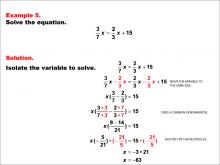
|
Math Example--Solving Equations--Equations with Fractions: Example 5 | Equations with Fractions: Example 5TopicEquations DescriptionThis example illustrates solving Equations with Fractions: Example 5 which involves fractions. These equations can be addressed by first removing the fractions by finding a common denominator and multiplying through. This transforms the equation into a standard linear form that can then be solved by isolating the variable. The specific equation in the image shows the importance of maintaining accuracy in operations, and understanding the process is crucial for advancing in algebra. |
Solving Fraction Equations |

|
Math Example--Solving Equations--Equations with Fractions: Example 5 | Equations with Fractions: Example 5TopicEquations DescriptionThis example illustrates solving Equations with Fractions: Example 5 which involves fractions. These equations can be addressed by first removing the fractions by finding a common denominator and multiplying through. This transforms the equation into a standard linear form that can then be solved by isolating the variable. The specific equation in the image shows the importance of maintaining accuracy in operations, and understanding the process is crucial for advancing in algebra. |
Solving Fraction Equations |

|
Math Example--Solving Equations--Equations with Fractions: Example 5 | Equations with Fractions: Example 5TopicEquations DescriptionThis example illustrates solving Equations with Fractions: Example 5 which involves fractions. These equations can be addressed by first removing the fractions by finding a common denominator and multiplying through. This transforms the equation into a standard linear form that can then be solved by isolating the variable. The specific equation in the image shows the importance of maintaining accuracy in operations, and understanding the process is crucial for advancing in algebra. |
Solving Fraction Equations |

|
Math Example--Solving Equations--Equations with Fractions: Example 5 | Equations with Fractions: Example 5TopicEquations DescriptionThis example illustrates solving Equations with Fractions: Example 5 which involves fractions. These equations can be addressed by first removing the fractions by finding a common denominator and multiplying through. This transforms the equation into a standard linear form that can then be solved by isolating the variable. The specific equation in the image shows the importance of maintaining accuracy in operations, and understanding the process is crucial for advancing in algebra. |
Solving Fraction Equations |

|
Math Example--Solving Equations--Equations with Fractions: Example 5 | Equations with Fractions: Example 5TopicEquations DescriptionThis example illustrates solving Equations with Fractions: Example 5 which involves fractions. These equations can be addressed by first removing the fractions by finding a common denominator and multiplying through. This transforms the equation into a standard linear form that can then be solved by isolating the variable. The specific equation in the image shows the importance of maintaining accuracy in operations, and understanding the process is crucial for advancing in algebra. |
Solving Fraction Equations |
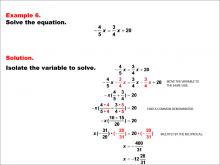
|
Math Example--Solving Equations--Equations with Fractions: Example 6 | Equations with Fractions: Example 6TopicEquations DescriptionThis example illustrates solving Equations with Fractions: Example 6 which involves fractions. These equations can be addressed by first removing the fractions by finding a common denominator and multiplying through. This transforms the equation into a standard linear form that can then be solved by isolating the variable. The specific equation in the image shows the importance of maintaining accuracy in operations, and understanding the process is crucial for advancing in algebra. |
Solving Fraction Equations |

|
Math Example--Solving Equations--Equations with Fractions: Example 6 | Equations with Fractions: Example 6TopicEquations DescriptionThis example illustrates solving Equations with Fractions: Example 6 which involves fractions. These equations can be addressed by first removing the fractions by finding a common denominator and multiplying through. This transforms the equation into a standard linear form that can then be solved by isolating the variable. The specific equation in the image shows the importance of maintaining accuracy in operations, and understanding the process is crucial for advancing in algebra. |
Solving Fraction Equations |

|
Math Example--Solving Equations--Equations with Fractions: Example 6 | Equations with Fractions: Example 6TopicEquations DescriptionThis example illustrates solving Equations with Fractions: Example 6 which involves fractions. These equations can be addressed by first removing the fractions by finding a common denominator and multiplying through. This transforms the equation into a standard linear form that can then be solved by isolating the variable. The specific equation in the image shows the importance of maintaining accuracy in operations, and understanding the process is crucial for advancing in algebra. |
Solving Fraction Equations |

|
Math Example--Solving Equations--Equations with Fractions: Example 6 | Equations with Fractions: Example 6TopicEquations DescriptionThis example illustrates solving Equations with Fractions: Example 6 which involves fractions. These equations can be addressed by first removing the fractions by finding a common denominator and multiplying through. This transforms the equation into a standard linear form that can then be solved by isolating the variable. The specific equation in the image shows the importance of maintaining accuracy in operations, and understanding the process is crucial for advancing in algebra. |
Solving Fraction Equations |

|
Math Example--Solving Equations--Equations with Fractions: Example 6 | Equations with Fractions: Example 6TopicEquations DescriptionThis example illustrates solving Equations with Fractions: Example 6 which involves fractions. These equations can be addressed by first removing the fractions by finding a common denominator and multiplying through. This transforms the equation into a standard linear form that can then be solved by isolating the variable. The specific equation in the image shows the importance of maintaining accuracy in operations, and understanding the process is crucial for advancing in algebra. |
Solving Fraction Equations |
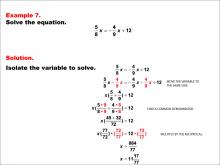
|
Math Example--Solving Equations--Equations with Fractions: Example 7 | Equations with Fractions: Example 7TopicEquations DescriptionThis example illustrates solving Equations with Fractions: Example 7 which involves fractions. These equations can be addressed by first removing the fractions by finding a common denominator and multiplying through. This transforms the equation into a standard linear form that can then be solved by isolating the variable. The specific equation in the image shows the importance of maintaining accuracy in operations, and understanding the process is crucial for advancing in algebra. |
Solving Fraction Equations |

|
Math Example--Solving Equations--Equations with Fractions: Example 7 | Equations with Fractions: Example 7TopicEquations DescriptionThis example illustrates solving Equations with Fractions: Example 7 which involves fractions. These equations can be addressed by first removing the fractions by finding a common denominator and multiplying through. This transforms the equation into a standard linear form that can then be solved by isolating the variable. The specific equation in the image shows the importance of maintaining accuracy in operations, and understanding the process is crucial for advancing in algebra. |
Solving Fraction Equations |

|
Math Example--Solving Equations--Equations with Fractions: Example 7 | Equations with Fractions: Example 7TopicEquations DescriptionThis example illustrates solving Equations with Fractions: Example 7 which involves fractions. These equations can be addressed by first removing the fractions by finding a common denominator and multiplying through. This transforms the equation into a standard linear form that can then be solved by isolating the variable. The specific equation in the image shows the importance of maintaining accuracy in operations, and understanding the process is crucial for advancing in algebra. |
Solving Fraction Equations |

|
Math Example--Solving Equations--Equations with Fractions: Example 7 | Equations with Fractions: Example 7TopicEquations DescriptionThis example illustrates solving Equations with Fractions: Example 7 which involves fractions. These equations can be addressed by first removing the fractions by finding a common denominator and multiplying through. This transforms the equation into a standard linear form that can then be solved by isolating the variable. The specific equation in the image shows the importance of maintaining accuracy in operations, and understanding the process is crucial for advancing in algebra. |
Solving Fraction Equations |

|
Math Example--Solving Equations--Equations with Fractions: Example 7 | Equations with Fractions: Example 7TopicEquations DescriptionThis example illustrates solving Equations with Fractions: Example 7 which involves fractions. These equations can be addressed by first removing the fractions by finding a common denominator and multiplying through. This transforms the equation into a standard linear form that can then be solved by isolating the variable. The specific equation in the image shows the importance of maintaining accuracy in operations, and understanding the process is crucial for advancing in algebra. |
Solving Fraction Equations |
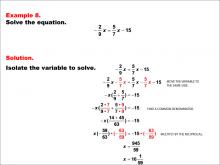
|
Math Example--Solving Equations--Equations with Fractions: Example 8 | Equations with Fractions: Example 8TopicEquations DescriptionThis example illustrates solving Equations with Fractions: Example 8 which involves fractions. These equations can be addressed by first removing the fractions by finding a common denominator and multiplying through. This transforms the equation into a standard linear form that can then be solved by isolating the variable. The specific equation in the image shows the importance of maintaining accuracy in operations, and understanding the process is crucial for advancing in algebra. |
Solving Fraction Equations |

|
Math Example--Solving Equations--Equations with Fractions: Example 8 | Equations with Fractions: Example 8TopicEquations DescriptionThis example illustrates solving Equations with Fractions: Example 8 which involves fractions. These equations can be addressed by first removing the fractions by finding a common denominator and multiplying through. This transforms the equation into a standard linear form that can then be solved by isolating the variable. The specific equation in the image shows the importance of maintaining accuracy in operations, and understanding the process is crucial for advancing in algebra. |
Solving Fraction Equations |

|
Math Example--Solving Equations--Equations with Fractions: Example 8 | Equations with Fractions: Example 8TopicEquations DescriptionThis example illustrates solving Equations with Fractions: Example 8 which involves fractions. These equations can be addressed by first removing the fractions by finding a common denominator and multiplying through. This transforms the equation into a standard linear form that can then be solved by isolating the variable. The specific equation in the image shows the importance of maintaining accuracy in operations, and understanding the process is crucial for advancing in algebra. |
Solving Fraction Equations |

|
Math Example--Solving Equations--Equations with Fractions: Example 8 | Equations with Fractions: Example 8TopicEquations DescriptionThis example illustrates solving Equations with Fractions: Example 8 which involves fractions. These equations can be addressed by first removing the fractions by finding a common denominator and multiplying through. This transforms the equation into a standard linear form that can then be solved by isolating the variable. The specific equation in the image shows the importance of maintaining accuracy in operations, and understanding the process is crucial for advancing in algebra. |
Solving Fraction Equations |

|
Math Example--Solving Equations--Equations with Fractions: Example 8 | Equations with Fractions: Example 8TopicEquations DescriptionThis example illustrates solving Equations with Fractions: Example 8 which involves fractions. These equations can be addressed by first removing the fractions by finding a common denominator and multiplying through. This transforms the equation into a standard linear form that can then be solved by isolating the variable. The specific equation in the image shows the importance of maintaining accuracy in operations, and understanding the process is crucial for advancing in algebra. |
Solving Fraction Equations |
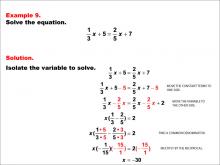
|
Math Example--Solving Equations--Equations with Fractions: Example 9 | Equations with Fractions: Example 9TopicEquations DescriptionThis example illustrates solving Equations with Fractions: Example 9 which involves fractions. These equations can be addressed by first removing the fractions by finding a common denominator and multiplying through. This transforms the equation into a standard linear form that can then be solved by isolating the variable. The specific equation in the image shows the importance of maintaining accuracy in operations, and understanding the process is crucial for advancing in algebra. |
Solving Fraction Equations |

|
Math Example--Solving Equations--Equations with Fractions: Example 9 | Equations with Fractions: Example 9TopicEquations DescriptionThis example illustrates solving Equations with Fractions: Example 9 which involves fractions. These equations can be addressed by first removing the fractions by finding a common denominator and multiplying through. This transforms the equation into a standard linear form that can then be solved by isolating the variable. The specific equation in the image shows the importance of maintaining accuracy in operations, and understanding the process is crucial for advancing in algebra. |
Solving Fraction Equations |